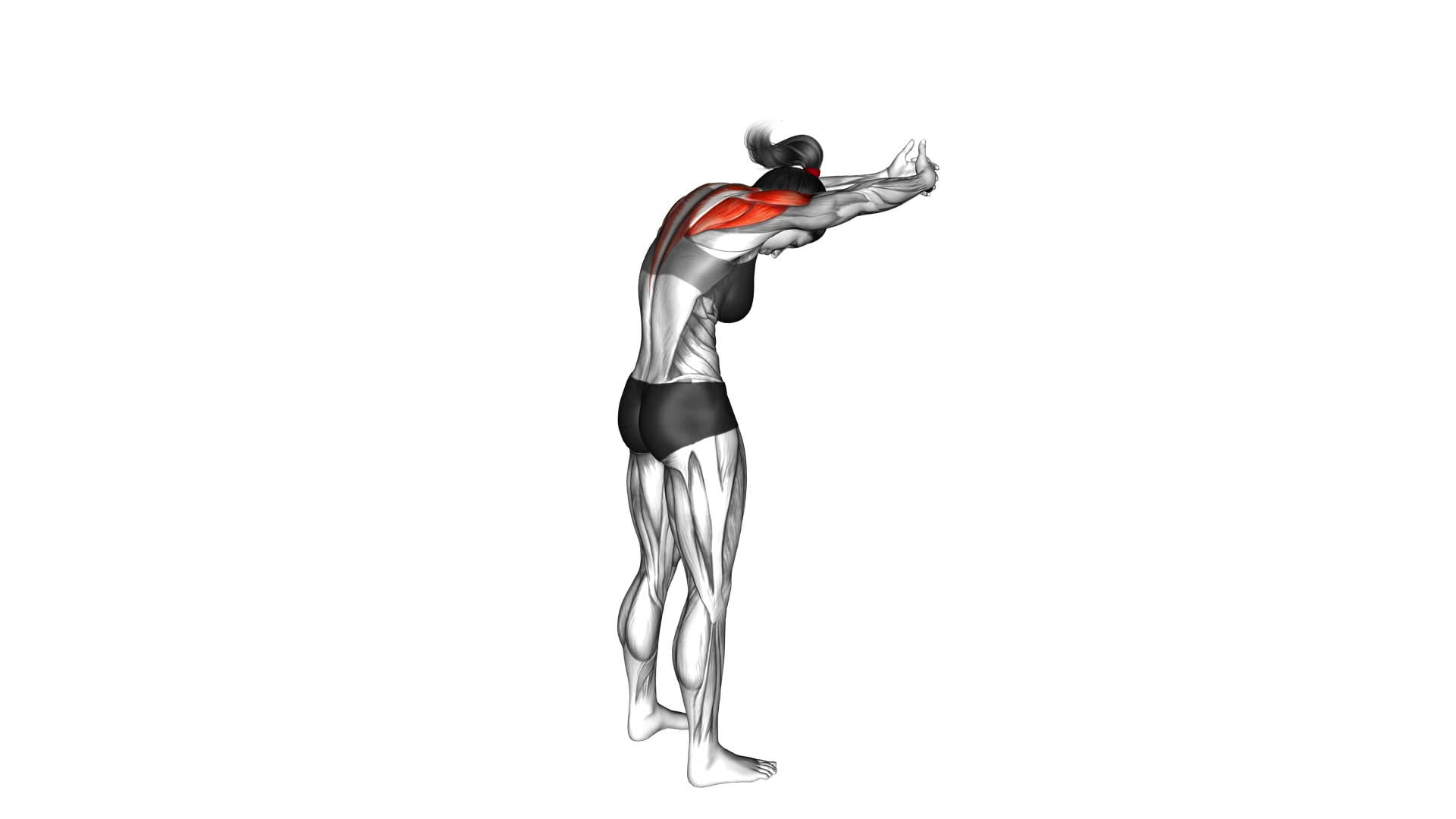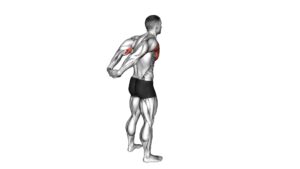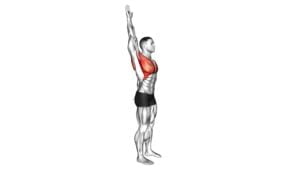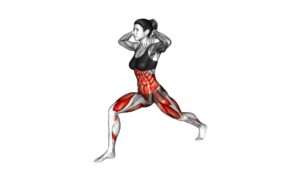Standing Upper Back and Shoulder Stretch (female) – Video Exercise Guide & Tips

Are you looking for a quick and effective way to relieve tension in your upper back and shoulders? Look no further!
Watch This Exercise Video
In this video exercise guide, we will show you a standing upper back and shoulder stretch specifically designed for females. By following our expert tips and proper form, you can enhance your flexibility and reduce muscle tightness.
Get ready to incorporate this stretch into your exercise routine and feel the benefits in no time. Let's get started!
Key Takeaways
- Improved posture
- Reduced tension in upper back and shoulders
- Muscle activation and strengthening
- Enhanced flexibility
Benefits of Standing Upper Back and Shoulder Stretch
You will experience improved posture and reduced tension in your upper back and shoulders with the Standing Upper Back and Shoulder Stretch. This stretch is an effective way to activate and stretch the muscles in your upper body, providing numerous benefits for your overall well-being.
One of the primary benefits of this stretch is muscle activation. As you perform the Standing Upper Back and Shoulder Stretch, you engage the muscles in your upper back and shoulders, helping to strengthen and tone these areas. This can lead to improved posture, as the muscles become more balanced and capable of supporting your spine properly.
In addition to muscle activation, this stretch also incorporates stretching techniques. By elongating the muscles in your upper back and shoulders, you can effectively reduce tension and tightness in these areas. This can help alleviate discomfort and promote a greater range of motion in your upper body.
In conclusion, the Standing Upper Back and Shoulder Stretch offers numerous benefits, including improved posture and reduced tension in your upper back and shoulders. By incorporating muscle activation and stretching techniques, this stretch can help you achieve better overall well-being.
Now, let's move on to discussing proper form and alignment for this stretch.
Proper Form and Alignment for the Stretch
To perform the standing upper back and shoulder stretch with proper form and alignment, there are several key points to keep in mind.
First, ensure that your shoulder blades are pulled back and down, engaging the muscles of your upper back.
Second, maintain a neutral position for your neck and spine, avoiding any excessive forward or backward curvature.
Shoulder Blade Position
Achieve proper form and alignment for the standing upper back and shoulder stretch by ensuring that your shoulder blades are in the correct position. Proper shoulder blade position is crucial for effective stretching and to avoid injury.
Here are three important points to remember:
- Retract and depress your shoulder blades: Pull your shoulder blades back and down, towards your spine. This helps to engage the correct muscles and prevents excessive tension in the neck and upper back.
- Maintain a neutral spine: Keep your back straight and avoid rounding or arching your spine. This ensures that the stretch is targeted to the upper back and shoulders, providing maximum benefit.
- Relax your neck and shoulders: Allow your neck and shoulders to relax, avoiding any unnecessary tension. This allows for better shoulder blade mobility and promotes upper back pain relief.
Neck and Spine Alignment
Maintain proper neck and spine alignment to ensure optimal form and alignment for the standing upper back and shoulder stretch.
Good posture is essential for overall health and wellbeing, as it helps to prevent muscle imbalances, reduce the risk of injury, and improve breathing and circulation.
When performing stretching exercises for neck and spine alignment, it's important to focus on maintaining a neutral spine position. Avoid excessive forward or backward bending of the neck and spine, as this can lead to strain and discomfort.
Instead, keep your head aligned with your spine and gently elongate the neck by lifting the crown of your head towards the ceiling. Remember to engage your core muscles to support your spine and maintain stability throughout the stretch.
Arm Placement and Tension
Align your arms and maintain tension for proper form and alignment during the standing upper back and shoulder stretch. By paying attention to your arm placement and tension, you can optimize the effectiveness of this exercise and improve your shoulder mobility. Here are three key points to keep in mind:
- Position your arms parallel to the ground, with your elbows bent at a 90-degree angle. This ensures that your arms are in the correct position for the stretch.
- Engage your muscles and create tension throughout your arms. This helps to stabilize your shoulders and maximize the benefits of the stretch.
- Avoid excessive tension or strain in your arms. While it's important to maintain some tension, don't overdo it. Find a balance that allows you to feel the stretch without causing discomfort or pain.
Variations and Modifications for Different Fitness Levels
Now let's explore the variations and modifications for different fitness levels in the standing upper back and shoulder stretch.
If you're a beginner, there are modifications you can make to make the stretch more accessible and gradually progress.
On the other hand, if you're at an advanced level, there are variations that can challenge you further and enhance the effectiveness of the stretch.
These modifications and variations cater to different fitness levels, allowing individuals to tailor the exercise to their specific needs and goals.
Beginner Modifications and Progressions
Start with one repetition of the standing upper back and shoulder stretch, gradually increasing the number as you progress. This exercise can be modified to suit different fitness levels, allowing beginners to start at a manageable level and gradually advance to more challenging variations.
Here are some beginner modifications and advanced progressions to consider:
- Beginner Modification: Use a lighter resistance band or no band at all to reduce the intensity of the stretch. Focus on maintaining proper form and gradually increase the resistance as you become more comfortable.
- Advanced Progression: Perform the stretch on an unstable surface, such as a balance board or Bosu ball. This will challenge your core stability and further engage the muscles of your upper back and shoulders.
- Advanced Progression: Increase the duration of each repetition. Start with a 10-second hold and gradually work your way up to 30 seconds or longer. This will increase the intensity and effectiveness of the stretch.
Remember to listen to your body and progress at a pace that feels comfortable for you. As you build strength and flexibility, you can continue to challenge yourself with more advanced variations.
Advanced Level Variations
As you progress to the advanced level, there are various variations and modifications available for different fitness levels in the standing upper back and shoulder stretch exercise. These advanced modifications and stretches are designed to challenge your flexibility and increase the intensity of the stretch.
One advanced modification is to interlace your fingers behind your back and lift your arms as high as possible while keeping them straight. This variation increases the stretch in your upper back and shoulders.
Another advanced stretch is to use a resistance band or towel to deepen the stretch by pulling your arms apart.
Remember to listen to your body and only attempt these advanced modifications if you feel comfortable and confident in your abilities.
Now, let's explore some common mistakes to avoid during the stretch.
Common Mistakes to Avoid During the Stretch
To maximize the effectiveness of the standing upper back and shoulder stretch, ensure proper form and technique. Common mistakes can hinder the benefits of the stretch, so it's important to be aware of them and avoid them.
Here are three common mistakes to avoid during the stretch:
- Rounded shoulders: One common mistake is allowing the shoulders to round forward instead of keeping them pulled back and down. This can reduce the effectiveness of the stretch and put unnecessary strain on the neck and upper back.
- Arching the lower back: Another mistake to avoid is arching the lower back excessively during the stretch. This can compromise the alignment of the spine and prevent the stretch from targeting the upper back and shoulders effectively. Keep the core engaged and maintain a neutral spine throughout the stretch.
- Holding the stretch too long: While it's important to hold the stretch for an adequate amount of time, holding it for too long can lead to overstretching and potentially cause injury. Aim to hold the stretch for about 20-30 seconds and repeat it on both sides.
Tips for Incorporating the Stretch Into Your Exercise Routine
Incorporate the stretch into your exercise routine by adding it as a regular component. The standing upper back and shoulder stretch can be a beneficial addition to your workout regimen, helping to improve flexibility, reduce muscle tension, and increase range of motion in your upper body.
To incorporate this stretch effectively, consider the following tips:
- Schedule it: Set aside dedicated time for stretching during your exercise routine. Aim for at least 5-10 minutes of stretching after your warm-up and before your main workout.
- Proper form: Pay attention to your body alignment and technique while performing the stretch. Keep your back straight, shoulders relaxed, and engage your core muscles for stability.
- Gradual progression: Start with gentle stretches and gradually increase the intensity and duration over time. This will allow your muscles to adapt and avoid any potential strain or injury.
- Consistency is key: Make it a habit to incorporate this stretch into your routine consistently. Regular stretching can help maintain flexibility and prevent muscle imbalances.
Precautions and Considerations for Females Performing the Stretch
Make sure you regularly incorporate the standing upper back and shoulder stretch into your exercise routine to ensure consistency and maximize its benefits. However, it's important to take certain precautions and safety considerations when performing this stretch, especially for females. Here are three key points to keep in mind:
- Proper form: When performing the standing upper back and shoulder stretch, it's crucial to maintain proper form to avoid any potential injuries. Make sure to keep your back straight and shoulders relaxed throughout the stretch. Avoid rounding your shoulders or hunching forward, as this can put unnecessary strain on your neck and upper back.
- Start slowly: If you're new to this stretch or have any underlying shoulder or back issues, it's essential to start slowly and gradually increase the intensity. Rushing into the stretch or pushing yourself too hard can lead to muscle strains or other injuries. Listen to your body and only go as far as you feel comfortable.
- Modify as needed: Every person's flexibility and range of motion are unique. If you find that the standing upper back and shoulder stretch is too challenging or uncomfortable, feel free to modify it to better suit your needs. You can use props like a wall or a chair for added support, or try alternative stretches that target the same muscle groups.
Frequently Asked Questions
How Often Should I Perform the Standing Upper Back and Shoulder Stretch?
To get the most out of the standing upper back and shoulder stretch, it's important to consider the frequency. Regularly performing this stretch can provide numerous benefits for your upper body. By incorporating it into your routine, you can improve flexibility, relieve tension, and promote better posture.
It's recommended to do this stretch at least three times a week to experience the full advantages. Remember, consistency is key when it comes to stretching and maintaining a healthy body.
Can I Perform This Stretch if I Have a History of Shoulder or Back Injuries?
If you have a history of shoulder or back injuries, it's important to approach this stretch with caution. It's recommended that you consult with a healthcare professional before attempting this exercise. They can assess your shoulder mobility and provide guidance on whether it's appropriate for you.
If this stretch isn't suitable, they may suggest alternative stretches that can help improve your shoulder mobility without aggravating your previous injuries.
Is It Safe to Perform This Stretch During Pregnancy?
During pregnancy, it's important to modify exercises to ensure safety.
When considering the standing upper back and shoulder stretch, it's advisable to consult with your healthcare provider. They can provide guidance on whether this stretch is appropriate for you during pregnancy.
If it's not recommended, they may suggest alternative stretches that are more suitable and safe.
Prioritizing your health and the health of your baby is essential, so always seek professional advice when unsure.
Should I Feel Any Discomfort or Pain During the Stretch?
During the standing upper back and shoulder stretch, you shouldn't feel any discomfort or pain. It's important to maintain proper technique to avoid any unnecessary strain.
Make sure to keep your shoulders relaxed and gently extend your arms behind you, feeling a stretch in your upper back and shoulders.
Beginners can modify the stretch by using a towel or strap to assist in reaching their hands behind their back.
Remember to listen to your body and stop if you experience any pain.
Can I Perform This Stretch Without Any Equipment or Props?
Yes, you can definitely perform this stretch without any equipment or props. It's a great exercise that requires only your body and a bit of space.
The standing upper back and shoulder stretch can be easily modified for beginners. Just make sure to listen to your body and start with a comfortable range of motion. As you become more comfortable, you can gradually increase the stretch.
Remember to breathe deeply and relax your muscles while performing this stretch.
Conclusion
Incorporating the standing upper back and shoulder stretch into your exercise routine can provide numerous benefits. Improved flexibility, reduced tension, and increased range of motion are just a few of the advantages you can expect.
To ensure safety and effectiveness, it is important to maintain proper form and alignment when performing this stretch. This includes keeping your back straight, shoulders relaxed, and neck in a neutral position.
Avoiding common mistakes is also crucial. For example, be mindful not to hunch your shoulders or strain your neck while stretching. It is important to listen to your body and not push beyond your limits.
Different fitness levels require different modifications. Beginners may need to start with a lighter stretch and gradually increase intensity over time. Advanced individuals can deepen the stretch by using props like resistance bands or yoga blocks.
Females should consider any precautions and individual considerations when engaging in this exercise. Pregnancy, previous injuries, or specific medical conditions may require modifications or consultation with a healthcare professional.
By following these tips and incorporating the standing upper back and shoulder stretch into your fitness routine, you can achieve optimal results and enjoy the many benefits this stretch has to offer.

Author
Years ago, the spark of my life’s passion ignited in my mind the moment I stepped into the local gym for the first time. The inaugural bead of perspiration, the initial endeavor, the very first surge of endorphins, and a sense of pride that washed over me post-workout marked the beginning of my deep-seated interest in strength sports, fitness, and sports nutrition. This very curiosity blossomed rapidly into a profound fascination, propelling me to earn a Master’s degree in Physical Education from the Academy of Physical Education in Krakow, followed by a Sports Manager diploma from the Jagiellonian University. My journey of growth led me to gain more specialized qualifications, such as being a certified personal trainer with a focus on sports dietetics, a lifeguard, and an instructor for wellness and corrective gymnastics. Theoretical knowledge paired seamlessly with practical experience, reinforcing my belief that the transformation of individuals under my guidance was also a reflection of my personal growth. This belief holds true even today. Each day, I strive to push the boundaries and explore new realms. These realms gently elevate me to greater heights. The unique combination of passion for my field and the continuous quest for growth fuels my drive to break new ground.



